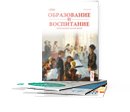To date, the state has developed many programs for the disabled, and work is underway. Early diagnosis and correction are important in the adaptation and education of a child in society as a whole. Special attention should be paid to the education of children with disabilities, disabled people. The main purpose of this education is to teach work, to join the search for their place in life, the formation of a flexible personality for life.
Keywords: mnemonics, pedagogy of a child, upbringing, correction, inclusive education, pedagogy.
Mnemonic technique, translated from Greek, means «the art of memory». This method helps to quickly and effectively memorize information. Didactic materials in the form of mnemonic charts can be used for explanation, memorizing poems, creative tasks, or completing tasks based on images. Mnemonic charts can be tangible, schematic, or schematic-based. If a child can work with a tangible object, tasks gradually become more difficult, and schematic models are offered to children. Such mnemonic charts help reduce the number of images.
Only where there is true trust in upbringing, will there be true discipline and work ethic. Work, work — it will overcome everything. This saying seems to encapsulate everything. When we think of children with disabilities, we often imagine them as incapable of work, reliant on parental care. However, work is a vital necessity for a child’s life. The work skills of children with disabilities do not develop immediately. These children need the help of parents and specialized professionals. They need opportunities to express themselves and interact with others. They are often very shy. There are so many children with talents. If these children are trained in labor, it would greatly help them find their place in life and their profession when they grow up. Solving the problems of individuals with limited abilities and improving their social conditions is one of the priorities of our country's social policy. In the Republic of Kazakhstan, the government has implemented many measures to integrate into the global educational space. Today, there are still many unresolved issues in the field of education. The directions for developing inclusive education were addressed in the State Development Program for 2011–2020. Discussions on the situation of people with disabilities in society and the difficulties they face are frequent. These issues range from the psychological adaptation of children with disabilities and their integration into society to the many challenges that still exist in the field of ensuring their dignity as individuals. These include various discriminatory practices that violate the child’s human rights and hinder their development and even their basic right to live. In implementing this goal, we do not always pay attention to the level of the student, which results in many students not reaching that level and ending up in the category of underachievers. The main reason for underachievement in schools is that the educational system does not align with the child’s intellectual system. Meanwhile, we continue to complicate educational programs [1].
One of the scientific achievements in providing education and upbringing for children with disabilities is mastering new technologies and using computers. The use of computers offers several didactic opportunities, such as developing logical thinking skills and fostering creative work. Theoretical topics are widely presented and explained in electronic textbooks. The concept of inclusive education, based on the principle of «equal opportunity for everyone», has only recently started to be implemented. This term is often used in conjunction with the concept of «Quality education for all». In other words, it involves providing equal education for children with disabilities and other socially vulnerable groups in general education schools, ensuring that they have the same opportunities as others. The formation of this issue is partly due to today’s society, as we have struggled to move beyond pitying individuals with disabilities. Only recently has the effort to create opportunities for these children to study and receive education in general education schools gained traction. The foundation of inclusive education is to provide high-quality education to all students, regardless of their individual differences.
We believe that if the reasons for each student's underperformance are identified and work is tailored according to the diagnosis of the child with a disability, the student's motivation for learning will increase, and their individual talents will become more evident. In solving the main practical tasks of modern education, developments in schools, as well as the effectiveness of the methods and tools used, can be determined through diagnosis. In this regard, educators need to provide a social, psychological, and pedagogical profile of their students and master methods of recognition and research. A personalized development program for each student would help uncover their unique talents and greatly assist them in finding their place in life and their profession.
In developed countries around the world, the method of educating children with disabilities alongside their healthy peers is used as a means of rehabilitation. In this context, a logical question arises: What is the most important need for a child? Of course, in order for children to communicate with each other, it is necessary to develop their language. Yes, without language development, their thinking and perception of the surrounding world become difficult. That’s why, nowadays, the use of mnemonic techniques in developing the language of pre-school children has become particularly relevant.
Mnemonic techniques are used as a specific approach to improving memory, and they are gaining the interest of preschool educators. The main goal of kindergartens is to help children develop comprehensively, address any developmental delays, and prepare them for school. A child's speech is the result of the coordinated work of several parts of the brain, while the articulation organs are simply the executors of commands sent from the brain.
Today, it is no secret that many children face the following challenges in language development:
A limited vocabulary;
Inability to correctly form word combinations in sentences;
Speech inabilities;
Inability to create a narrative or descriptive story on a given topic;
Inability to express their thoughts clearly.
In such a situation, the question arises: How can we help the child? How can we assist them in expressing their thoughts sufficiently, in a connected and orderly manner, and in grammatically correct speech? This is the crucial question to address.
In this case, the mnemonic technique comes to our aid, where the approach gradually becomes more complex, starting from the easiest to the more challenging. To implement this approach, it is necessary to begin with the simplest mnemonic square, then move to simple mnemonic paths, and finally progress to mnemonic tables.
This step-by-step transition helps to build a strong foundation for memory and cognitive development, ensuring that children can improve their ability to recall information, enhance their language skills, and develop better thinking processes in a structured way. Each stage presents a more advanced way to engage the child, making learning both effective and accessible [2, p. 26–37].
A mnemonic table is a didactic tool for developing children's language skills. The uniqueness of this method lies in using symbols of memory tools instead of images of objects themselves. These symbols are closely linked to linguistic materials. For instance, to represent wild animals (forest animals), the image of a pine tree is used, and for domestic animals, the image of a house is applied.
Traditional language development activities for children can be carried out in the following directions:
1. Enriching vocabulary
2. Teaching children to create and invent stories
3. Memorizing poems
4. Solving riddles
Mnemonic tables, which represent specific information, serve as didactic materials in this process. By incorporating such tools, children can more effectively engage with and remember the linguistic content while developing their language skills in a creative and structured manner.
The content of a mnemonic table should be built using a graphical or semi-graphical representation of a fairy tale character, the actions of a natural phenomenon, or the plot of a story. The key aspect is visuality, where the reference diagram and the illustrated image must be clear and understandable for the child.
The use of mnemonic tables involves three levels:
1. Observing the table and identifying what is depicted — This step focuses on the child looking at the table and recognizing the images or symbols shown.
2. Encoding the information — The child associates a symbol or sign with a specific image or concept.
3. Moving on to narrating a story or fairy tale — The child then uses the mnemonic tool to retell or create a story, applying the symbols to structure the narrative.
By following these stages, children can effectively utilize mnemonic tables to enhance their language and cognitive development while engaging with stories and concepts in a more interactive way.
In my experience, I encountered many difficulties while working with children, but working creatively was interesting and greatly helped me to gain experience as well. To avoid making this explanation dry, let me give you an example:
Using a mnemonic table to teach a poem, children are shown pictures:
1. Which season is depicted in the picture? (summer image)
2. What kind of bird is shown? (picture of a goose)
3. What do we see in the picture? (a flower)
4. What insect is depicted in the picture? (a butterfly)
Now, let's try to memorize the poem using the pictures:
1st picture — Summer has come, shining bright
2nd picture — The goose has come, honking loud
3rd picture — The butterfly landed on the flower
4th picture — Its wings fluttering in the breeze. [3, p. 10].
It should be noted here that mnemonics, derived from the Greek language, refers to the «art of memory» and is a set of rules and techniques that facilitate memory retention through the use of natural associations. It helps to recall necessary information through artificial concepts. Additionally, it is viewed as a system of methods and techniques that ensure effective memory retention, the storage and retrieval of information, and the development of language in children regarding their understanding of the surrounding environment.
As seen in the example above, mnemonics is an invaluable method for teaching children to correctly pronounce sounds, construct grammatically correct sentences, and create connected stories based on lexical topics. This is achieved through games, reference charts, and models, all of which help expand children's vocabulary and experiences.
It also develops children's creative imagination, memory abilities, visual attention, and thinking skills through constructive and visual images, fostering ingenuity. Another significant advantage of this method is its effectiveness in reducing learning time by transforming symbols into visual images, working with mnemonic charts, models, and reference patterns, and training children to master techniques and methods.
It is well known that interdisciplinary connections play a crucial role in language acquisition. The topics covered in lessons are reinforced in physical education, music, environmental studies, English, language development, and mathematics classes. This integrated approach strengthens children's vocabulary, comprehension, grammatical structure of sentences, and the correct pronunciation of language-specific sounds [4].
According to psychologists and educators, the motivation to learn begins to develop early in preschool children. Even if children are not taught to read and write at home or in kindergarten, some of them manage to learn to read and start recognizing individual letters. Before they master reading on their own, children first read letter by letter. While reading letter by letter, children make many mistakes, do not understand what they are reading, and lose the rhythm of reading. Today, there is a strong focus in pedagogy on teaching children to read starting from the age of six. The opinion that children should learn to read in kindergarten is becoming more common. This is because, from an early age, children begin using their mother tongue. Gradually, this develops into the formation of sentences, and they come to understand that sentences are made up of words, words are made up of syllables, and syllables are made up of sounds. Sounds are represented by letters in writing. In order to teach reading and writing, a child needs to understand that language is made up of words and that sounds are represented by letters.
Language development work refers to activities related to words, sentences, and pronunciation. Therefore, prominent scholars who specifically study the skills of children's thinking and speaking have addressed issues such as the development of preschool children's vocabulary, their speech characteristics, their ability to understand words and grasp grammatical categories, mastering systematic speech, and the role of language in developing children's thinking and mental processes. These are essential areas of focus that highlight the importance of language in early childhood development [5].
References:
- Polyanskaya T. B. «Using the Method of Mnemonics in Teaching Storytelling to Preschool Children», 2009.
- Bolsheva T. V. Learning through Fairy Tales. Developing Preschoolers' Thinking with the Help of Mnemonics: Educational and Methodical Guide. 2nd ed., corrected. — St. Petersburg: «Detstvo-Press», 2005. — 96 pages.
- Polyanskaya T. B. Using the Method of Mnemonics in Teaching Storytelling to Preschool Children: Educational and Methodical Guide. — St. Petersburg: LLC «Publishing house «Detstvo-Press», 2010. — 64 pages.
- Bolsheva T. V. Learning through Fairy Tales. Developing Preschoolers' Thinking with the Help of Mnemonics: Educational and Methodical Guide. — St. Petersburg: Detstvo-Press, 2005.
- Guryeva N. A. One Year Before School. Developing Memory. Workbook of Mnemonics Exercises. — St. Petersburg: Svyetlyachok, 2000.







